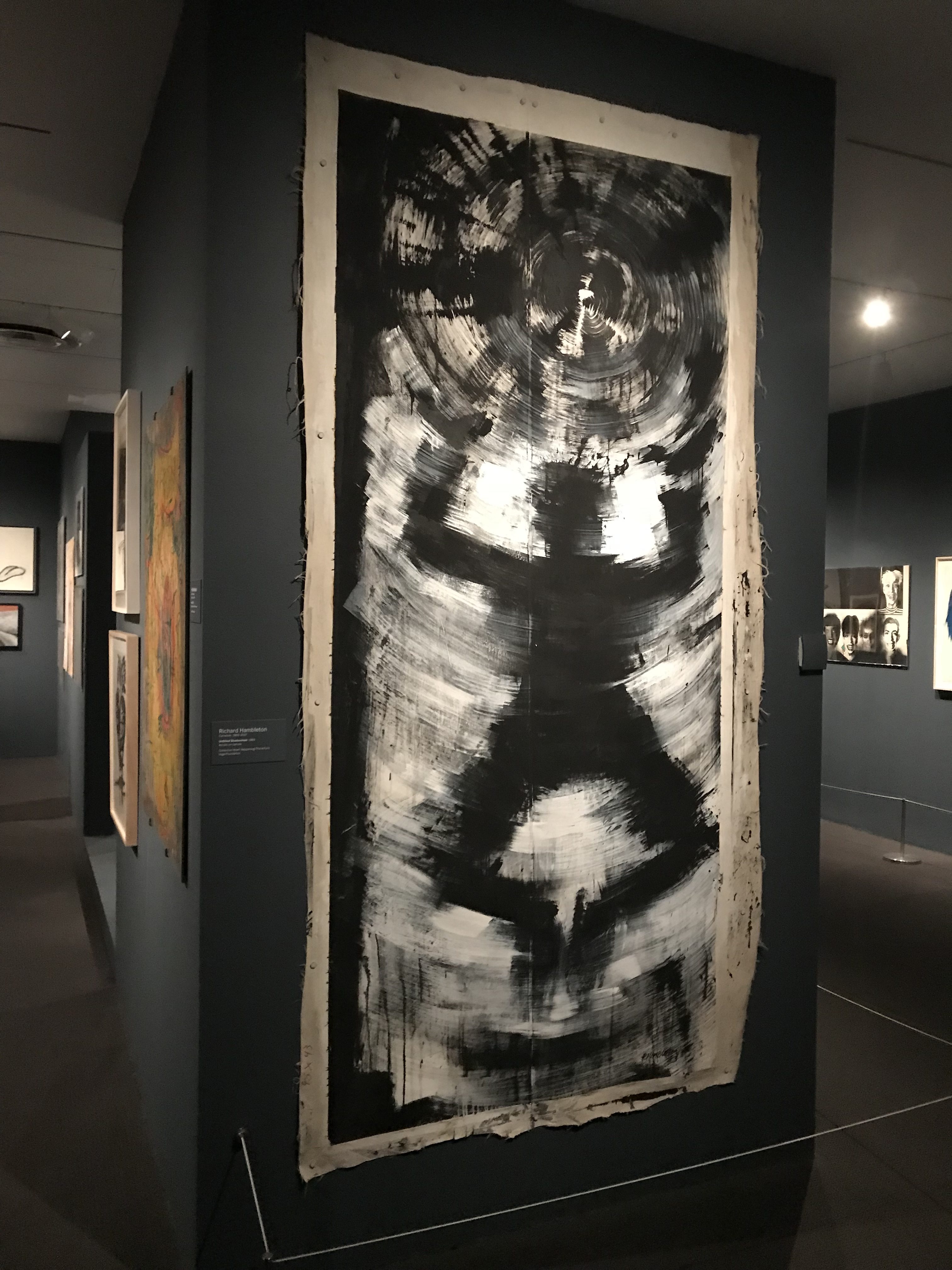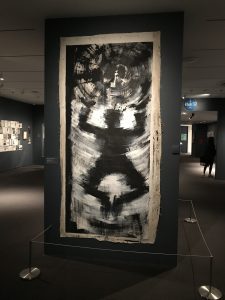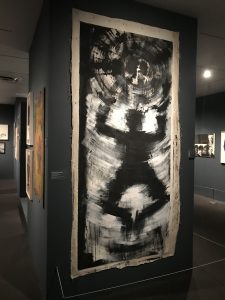Description:
Untitled Shadowman (1983) by Richard Hambleton is a painting done with acrylic on canvas. It’s measurements are 95 x 42 inches, without a wood backing for the canvas. The canvas seems to be two large canvases attached to each other in the centre, to create one long canvas in height. Considering its age and possibly how it was stored throughout the years, the painting is in fairly good condition. The edges of the canvas has tears but the original quality and boldness of the overall painting has been preserved, and furthermore, the state it’s in adds to the narrative of the piece.
The main subject focus of the painting is the Shadowman, in 2d form. The Shadowman, painted in black, stands in front of a white portion of the background and above the figure seems to be some sort of whirlwind phenomena. The technique of the painting involves large brush strokes, which gives the painting a brushed texture to create a motion blur effect. Due to the motion blur effect, the painting is very raw but still creates shapes, involving no straight lines. Due to the nature of the piece, it looks like it was completed quickly and furthermore, that contributes to the whole motif of the Shadowman being hazy and mysterious. It’s uncertain what is actually happening in the panting due to the concept of the Shadowman, but the elements in the piece give an idea of chaos and the dangers of shadows.
Deduction:
In order to fully capture the presence and intended impact of the painting, its important to step a few meters back and view the piece from afar. During this time the viewer is analysing the painting, the uncertainty of the viewer not knowing who the figure is or what is happening, provokes the viewer to come up with a variety of different conclusions and speculations. Time of day and location of the setting isn’t even expressed clearly and that makes it even more compelling. The painting involves a black and white colour scheme, and because of this powerful color choice, it forces the viewer to really think about the subject matter and the message of the piece, rather than focusing on its beauty aspects. The Shadowman also may make the viewer uneasy due to a life-sized black silhouette directly facing you and represents the idea of the dangers of shadows.
With regards to movement in the painting, the Shadowman is being sucked into a whirlwind and it feels in motion due to that. The technique of the brush strokes give off this effect and to see the strokes in person is very powerful. The strokes have motion and character and to experience that rawness in real life gives the piece even more value and takes the viewer back in time to when Hambleton created the piece. All in all, its a piece that has subliminal messages, nothing literal. That is possibly what the best thing about the piece is because the viewer and interpret the piece in a variety of different ways rather than the piece being objective and telling you directly what its about.
Personally, this piece triggers curiosity and fright. Firstly, it trigger curiosity because as a viewer, you wonder what state of mind Richard Hambleton was in during the construction of the piece and it makes you wonder why he chose to do some things in a certain way. As a viewer, it makes me want to know what sort of influence the shadow had on him and how the shadow has been this platform to tell stories and share messages with the world. In a more literal sense, it triggers curiosity because a viewer will want to know whats happening in the piece but it will never tell you that. Secondly, this piece triggers fright because a black silhouette can be so intense and it also reminds the viewer of the stereotypical silhouette in scary movies. In scary movies, the shadow is labeled as danger and this label is exemplified in Hambleton’s piece.
Speculation:
During the peak of the Shadowman taking over the streets of New York City, these Shadowman paintings were strategically placed for maximum impact on viewers who walk past the paintings. You can find these paintings in dark alleys or sharp corners where you would be greeted by the large black shadow as you make a turn. With the accumulated power of the shadow man, Richard Hambleton started to replicate this phenomena in Paris, London, Rome, and a few more major cities in Europe. A significant in history for the piece was when Hambleton painting seventeen life-size figures of the Shadowman on the East side of the Berlin Wall and a year later, doing it as well on the West side of the wall. According to a close friend of Hambleton, these Shadowmen were actually there to offer a sense of security to the people in a city, rather than scaring them. This sort of information forces the viewer to view the Shadowmen in a different light and to try to understand how this large Shadow can offer a sense of safety.
- What was the value of these paintings as time went by?
The Shadowmen painted during the peak years of Hambleton remain to have high value and are kept by private collectors but in his last years of life, smaller variations of the Shadow man were being sold for a few hundred dollars. With some speculation, Hambleton was selling smaller variations of the Shadowman for a few hundred dollars, for food money.
2. How was just a black life sized silhouette so simple, yet so powerful?
3. Were these shadow men across the city being painted at the early morning hours of the night, popping up the next morning? Like some of the famous graffiti artists’ techniques like Banksy?
4. What were Hambleton’s motives ?
Hambleton wasn’t a careerist, he ultimately just wanted to paint and thats all he cared about. In an interview with a close friend of Hambleton, he states, “He was conscientiously fighting against the communication of art and a generation of artists who wanted to be famous and make money.






